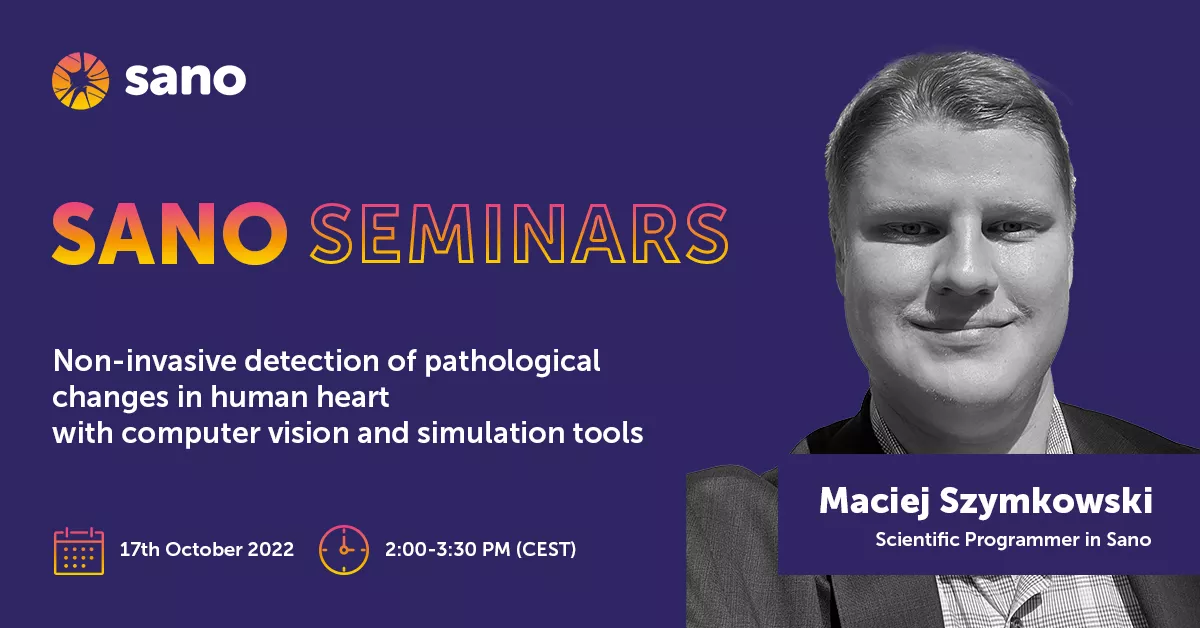
76. Non-invasive detection of pathological changes in human heart with computer vision and simulation tools
Maciej Szymkowski – Scientific Programmers Team, Sano Centre for Computational Science, Krakow, PL
Abstract
In this talk, I will attempt to provide an overview of the methodology of non-invasive human heart analysis and the detection of pathological changes. The main de novo aspect of the proposed workflow is the use of computer vision algorithms and simulation tools, for the diagnosis of 2D MRI and 3D CT heart sample series. It needs to be pointed-out that one of the serious illnesses detected within such images is pulmonary hypertension. This project is undertaken in cooperation with the Technical University of Cluj Napoca, (represented by dr Angela Lungu) and the University of Sheffield (in the team of prof. Rodney Hose and prof. Ian Halliday). As the vital part of the work, we also consider modelling of arterial blood pressure, with the information acquired from CT/MRI image series. Initially, I will review the recent state of the art (related to heart modelling and detection of cardiac pathophysiology) and I will then proceed to describe the most significant methodological innovations. I will then proceed to present a proposed pipeline and methodology for 2D MRI and 3D CT heart samples’ series processing and analysis. Finally, conclusions related to the presentation will be given.
References:
- Barber, D., Hose, R.: “Automatic segmentation of medical images using image registration: diagnostic and simulation applications”, Journal of Medical Engineering & Technology, vol. 29, issue 2, 2005, pp. 53-63, DOI: 10.1080/03091900412331289889
- Barber, D., Valverde, J., Shi, Y., et. al.: “Derivation of aortic distensibility and pulse wave velocity by image registration with a physics-based regularization term”, International Journal for Numerical Methods in Biomedical Engineering, vol. 30, issue 1, 2014, pp. 55-68, DOI: 10.1002/cnm.2589
- Bertoglio, C., Barber, D., Gaddum, N., et. al.: “Identification of artery wall stiffness: In vitro validation and in vivo results of a data assimilation procedure applied to a 3D fluid-structure interaction model”, Journal of Biomechanics, vol. 47, issue 5, 2014, pp. 1027-1034, DOI: 10.1016/j.jbiomech.2013.12.029
- Nogami, M., Ohno, Y., Koyama, H., et. al.: „Utility of phase contrast MR imaging for assessment of pulmonary flow and pressure estimation in patients with pulmonary hypertension: Comparison with right heart catheterization and echocardiography”, Journal of Magnetic Resonance Imaging, vol. 30, issue 5, 2009, pp. 973-980, DOI: 10.1002/jmri.21935
- Hong, Z., Garcia, J.: “Pulmonary Artery Remodeling and Advanced Hemodynamics: Magnetic Resonance Imaging Biomarkers of Pulmonary Hypertension”, Applied Sciences, vol. 12, issue 7, 2022, DOI: 10.3390/app12073518
About the author
Maciej Szymkowski (Member, IEEE) was born in Bialystok, Poland, in 1994. He received the B.Sc. and M.Sc. Eng. degrees, in 2017 and 2018, respectively. Since 2018, he has been working as a Research Assistant with the Faculty of Computer Science, Białystok University of Technology in Biometrics Laboratory, under the supervision of Professor Khalid Saeed. From 2021 he worked in AGH University of Science and Technology in Cracow. Currently, he is also a Scientific Software Developer in Sano – Centre for Computational Personalized Medicine, cooperating with the Technical University of Cluj Napoca and the University of Sheffield. To date, he has published 31 research works in peer-reviewed journals and conference proceedings. His main research interests relate to biometrics, medical image processing, simulation and artificial intelligence, machine learning.

